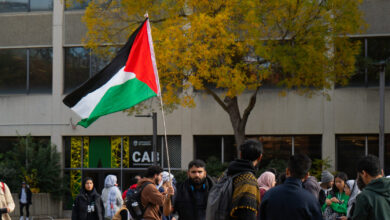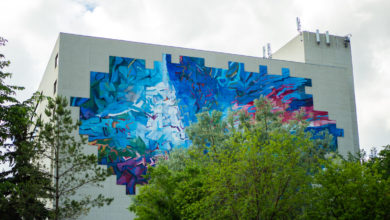U of A students are experiencing sexual and gender-based violence, survey finds
A report funded by the Government of Alberta found that 64 per cent of the students surveyed experienced sexual and gender-based violence since arriving at the U of A.
 Macy Wong
Macy WongOn university campuses, sexual and gender-based violence (SGBV) is a major cause for concern. According to data published by Statistics Canada in 2020, 71 per cent of university students witnessed or experienced SGBV in 2019. In Alberta, approximately 1.8 million Albertans have experienced SGBV. However, it continues to be largely underreported by post-secondary students.
That’s why, from January 30 to March 16, 2023, the market research company Leger surveyed 12,948 students from 26 publicly-funded post-secondary institutions in Alberta on SGBV. Using the responses from the survey, Leger created a report based on their findings.
The survey was funded by the Government of Alberta, and sought to understand the “attitudes and beliefs about SGBV and consent; perceptions of the institution landscape regarding SGBV; awareness and knowledge of institution supports; and experiences of SGBV.”
“Results from the survey will help the Ministry of Advanced Education and Albertan post-secondary institutions enact meaningful and effective policies and programs that help prevent SGBV and promote gender equality,” the report read.
Of the initial 12,948 students surveyed, 2,486 were from the University of Alberta, creating a response rate of 11.3 per cent. The results were not weighted, which means the data didn’t undergo calculations to bring them more in line with the population being studied.
In June, a final presentation was created and released based on the U of A’s results. The report found that “U of A students are experiencing SGBV.”
SGBV is high at the U of A, but may not “tell the whole picture,” UASU vice-president (student life) says
The original report showed that 50 per cent of students surveyed had experienced SGBV since attending their post-secondary institution in Alberta. At the U of A, this number was significantly higher at 64 per cent. According to the report, the provincial average is 43 per cent.
The report specific to the U of A found that the most common form of SBGV experienced by students surveyed was sexual harassment — 59 per cent of those surveyed reported experiencing sexual harassment since becoming a student. The report defined sexual harassment as “any unwelcome verbal or physical sexual advances, requests, or conduct.”
Deb Eerkes, the U of A’s sexual violence response coordinator, said that this number has a lot to do with the respondents of the survey. She mentioned that the data is not representative of all students at the U of A, but instead just those who chose to answer.
“We have a very aware student population here. We have a sexual assault centre on campus. We have a lot of activity that’s been going on. So, we’ve just had better responses from people who choose to say something.”
As a result, this data doesn’t indicate that there are more occurrences of SGBV at the U of A, Eerkes said. Instead, it shows that those who have experienced SGBV chose to respond to the survey.
Michael Griffiths, U of A Students’ Union (UASU) vice-president (student life), said that “we want that number to be zero.” But, he added that reports don’t “tell the whole picture,” and the reporting structure must be looked at.
“It may be the case that more students at the U of A are comfortable reporting when they do experience instances of SGBV. If this is the case with this stat, that would be a good thing — we want our survivors to be able to seek help,” Griffiths said.
However, he added that there’s a “very high level of students experiencing SGBV here,” which the UASU is aware of. He said advocacy work is being done by the UASU, such as with the new SGBV policy and the hiring of Eerkes, who began her term in 2022.
“But we need to continue to go beyond that. We’re now getting a lot more data on these statistics, and students are reporting. But how are we actually making the transformations at our institution to support these students?”
U of A students not accessing institutional supports
The survey found that although students are aware of supports offered at the U of A, they’re not accessing them. Of those surveyed, 75 per cent said they were aware of wellness supports offered at the U of A. More specific to SGBV-related services, 67 per cent were aware of the U of A’s SGBV policy and 70 per cent knew of the U of A Sexual Assault Centre (UASAC).
However, only 7 per cent of those surveyed who had experienced SGBV since attending the U of A told someone at the university. Of that percentage, only 35 per cent told someone at a service specialized for SGBV. As well, 51 per cent of respondents said they didn’t know where to go to file a report after they experienced SGBV.
“After you experience something like SGBV, it’s really difficult to speak up,” Griffiths explained.
“We need to design our services in a way that is going to be the most accommodating and comfortable for our survivors to come forward.”
He added that the UASU has been advocating for the ability to report and access support from various offices on campus. One related resource, he said, is the newly released Options Navigations Network (ONN).
ONN is a group of units at the U of A that assist those who have experienced SGBV in understanding what their options are going forward. The staff at ONN receive training that is survivor-driven, so they can provide help that is “very personalized and technical,” Eerkes said.
“That burden should not be on the survivor to find the right office on campus. That’s something that the ONN is doing a better job at addressing,” Griffiths said. “We’re really happy that that work is being done, and we’ve been pushing to make those systemic changes as an institution.”
Eerkes mentioned that SGBV covers a “wide range of behaviours,” and not all of them are things that can be reported to the university or police, such as cat calls or jokes.
“It’s too low level,” Eerkes said. “One of the reasons people give for not coming forward is that it wasn’t serious enough. So I think if we’re talking about believing survivors when they’re talking about serious things that happen, we also have to trust and believe them when they say, ‘it’s not serious enough for me to seek help.’”
“We don’t want to make survivors feel like they should be coming forward if that’s not what they want to do. Doing nothing is a perfectly valid option.”
Eerkes added that just because survivors aren’t telling the university or the police doesn’t necessarily mean they’re not telling anyone. She said that SGBV is a “very personal thing.”
“You’re not going to go to an official unless you really need to. You’re going to go to someone you trust, someone who will believe you,” Eerkes said. “The good news is they’re telling somebody.”
Eight per cent of students surveyed experienced SGBV in on-campus or campus-affiliated housing, survey finds
According to the report, 55 per cent of respondents said they experienced sexual harassment off-campus. The report also found that eight per cent of students surveyed experienced sexual harassment in on-campus or campus-affiliated housing, which includes dorms and residences. SGBV in residences was a known problem before the report, Griffiths said, and remains to be “something that the university needs to do more to address.”
The UASU has introduced consent literacy training for incoming residents, he added. Residents must complete a mandatory module before they can move in. As well, Griffiths said that over the last few years, residence assistants have received “more robust training.”
“[There’s] always more work to be done there. We [knew] that in the past, and it continues to be just that much more potent of a concern in residence.”
Eerkes mentioned that the U of A has the biggest residence system in Alberta, which wasn’t discussed in the survey. Because the survey wasn’t weighted, this statistic wasn’t adapted to fit the sample size, causing a sample imbalance.
“We have students on campus doing their campus activities 24 hours a day. Of course that number is higher.”
UASU explores Sexual Assault Centre of Edmonton as alternative, work with university ongoing “to repair that trust with students”
UASAC’s former director, Samantha Pearson, was let go in November. This followed both Pearson and UASAC being listed as signatories on an open letter calling on Members of Parliament (MP) who support a ceasefire in Gaza to resign in protest. Griffiths said that the UASU’s priority is making sure support is continuously available for students. He added that not only should students feel comfortable accessing resources, but resources need to have the capacity to accommodate students.
“There’s a bit of work directly with the university to repair that trust with students and make sure that [UASAC] is taking the right direction going forward. And, will have that capacity to be able to serve students,” Griffiths said.
Griffiths added that in the aftermath of Pearson being let go, the UASU and university looked at the Sexual Assault Centre of Edmonton (SACE) as an alternative resource.
“[We’ve] explored … what their capacity is like to support students who UASAC might not have the capacity to take on, or students [who] no longer feel comfortable going to that service.” Griffths said that there is a broader emphasis on reinforcing survivor-centric institutions, and ensuring “capacity across the board” for students to access support.
The Gateway reached out to SACE, but they were unable to provide an interview in time for publication. However, Mary Jane James, SACE’s chief executive officer, provided written answers to questions.
According to James, SACE often works with post-secondary institutions in Edmonton that don’t have campus-specific sexual assault centres. However, SACE also works with UASAC in sharing resources.
When asked if SACE has noticed new trends with SGBV in post-secondary institutions, James said that “it is difficult to observe over-arching trends.” But, SACE has observed that post-secondary governing bodies are increasingly supporting SGBV-specific positions or program coordinators.
“This demonstrates increasing investment in preventing, supportively responding to, and educating campus communities about SGBV issues,” James said. As well, James added that there’s a wider trend of post-secondary students having higher SGBV literacy.
Report found that U of A students were more likely to take advantage of training regarding SGBV compared to other universities surveyed
When initially reading the report, Eerkes said that you have to “move past the feeling of ‘this is awful’.”
“You start out with that feeling of this is horrible, it’s still happening. We have not yet been able to stop SGBV, and we will never be able to stop [it] because it happens out in the world, and we’re a little microcosm.”
Once those feelings are gone, the commentary and data from the report can be an educational resource for understanding what preventionary measures need to be put in place.
“What are things that we can do to prevent [SGBV] as much as possible, and then to respond appropriately?” Eerkes asked.
As well, she said that most importantly, conditions need to be created where it’s harder to commit acts of SGBV. Eerkes mentioned that the report found that U of A students were more likely to take advantage of and use training regarding SGBV compared to the other post-secondary institutions surveyed. Notably, 69 per cent of those surveyed said that training on SGBV bystander intervention was most valuable.
To Eerkes, bystander intervention isn’t the expectation for witnesses to SGBV to be “superheroes” when they witness something happening. She says this isn’t the first response for a lot of people. Instead, people should intervene on smaller instances of SGBV, like locker room talk, she said. If these smaller instances are unacceptable, that sends the message that all SGBV is unacceptable.
Eerkes said that she’s been focusing on developing training resources based on these numbers. She added that this new training program will be rolled out in 2024. As well, this program has given her information that she can draw from when she creates educational resources for the university community.
Eerkes’ role as the sexual violence response coordinator comes up for renewal in early 2024. She says that the university has many different systems, policies, and collective agreements all operating and working on SGBV concurrently. This also means that students, faculty, and staff interact with each other constantly. Eerkes said this is why coordination is necessary.
“We want to make sure … that no matter who experienced and who subjected them to [SGBV], they get the same response,” she said. “We’re working under the same principles even if we don’t have exactly the same procedural response.”
Ministry of Advanced Education continues to work with stakeholders to address SGBV in post-secondary
The Gateway reached out to the Government of Alberta’s Ministry of Advanced Education for a comment regarding the report. A written response on behalf of Minister of Advanced Education Rajan Sawhney was provided.
It mentioned that the government has “successfully negotiated a $54 million funding agreement with the federal government that will support a 10-year, made-in-Alberta strategy to end gender-based violence.”
This funding is coming from the National Action Plan to End Gender-Based Violence, which focuses on support, prevention, a responsive justice system, Indigenous-led approaches, and investments in social infrastructure. Women and Gender Equality Canada is working with each province and territory to place flexible agreements, special to each jurisdiction, which will support the plan’s implementation.
The response also said that the Ministry of Advanced Education “has provided $2.5 million in dedicated funding to post-secondary institutions to raise awareness and increase prevention of SGBV and implement training.”
This funding was announced in February 2022 and put toward developing the province-wide survey to understand sexual violence and harassment on campuses. The results were compiled by Leger and released by the government in August. This was the first time that data specific to Alberta about SGBV on post-secondary institutions was gathered. “We continue to work with stakeholders to address this important issue,” the response continued.
“Ensuring campuses are safe and have gender-based violence policies and services that truly make an impact is a priority for Alberta’s government.”
“The university really needs to take it seriously” UASU vice-president (student life) says
Eerkes said that passionate people have been working to address SGBV for decades, but the numbers haven’t changed. Going forward, “we can’t keep looking at SGBV as an individual problem,” she said.
“It’s not just one individual hurting another individual. It’s a petri dish of the world where this is allowed to go on. And that’s what we have to clean up.”
When reading the report, Griffiths said that there wasn’t a lot of data that he found really surprising.
“Reading that report was incredibly hard. And in a lot of ways, incredibly disappointing,” he said.
Griffiths emphasized that a lot of work still needs to be done in addressing SGBV at the university.
“This is really real for the students who do experience it, and it changes the experience they have in university. It changes their life path for a lot of these students. The university really needs to take it seriously. And the provincial government really needs to take it seriously as well.”




